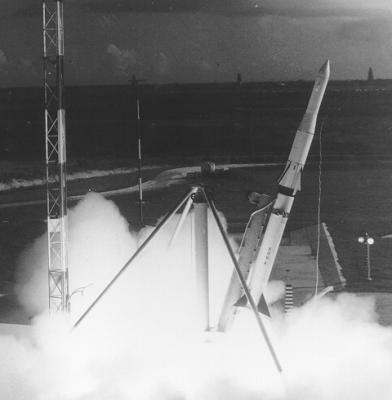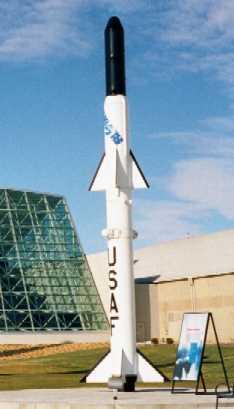Ford MER-6 Blue Scout ERCS
In September 1961, the Strategic Air Command of the USAF issued a requirement for a rocket-borne UHF communication system in defense emergencies when conventional communication links were disrupted. This system, called ERCS (Emergency Rocket Communications System), was to provide a reliable and survivable connectivity between command posts and launch control centers. The ERCS UHF transmitters carried prerecorded force execution messages that were transmitted to all units within line of sight of a rocket's apogee.
Air Force Program 279L was initiated for deployment of an interim ERCS capability on Ford Aeronutronics XRM-91 Blue Scout Junior rockets. The XRM-91 was a four-stage rocket based on LTV's Scout family of launch vehicles, which first flew on 21 September 1960. Blue Scout Junior rockets and other Scout derivatives were used as launch vehicles by the USAF throughout the 1960s under the basic designation of SLV-1 Scout. The Blue Scout Junior variant used for Program 279L was designated SLV-1C. It replaced the XRM-91's Alcor third stage by an Altair and omitted the fourth stage.
 |
| Photo: USAF |
| XRM-91 |
The first launch of an SLV-1C rocket equipped with an ERCS occurred on 31 May 1962. In July 1963, the Blue Scout Junior ERCS was declared operational, with rockets based at three locations in Nebraska. Shortly before, in June 1963, the ERCS-equipped SLV-1C had received the designation MER-6A.
 |
| Photo: Scott Murdock |
| MER-6A |
The ultimate ERCS used modified LGM-30F Minuteman II missiles as carrier vehicles. The Minuteman ERCS (possibly tentatively designated LEM-70A) became operational in October 1967, and in December 1967 the MER-6A rockets had been withdrawn from service. The Minuteman ERCS remained operational until the early 1990s.
Specifications
Note: Data given by several sources show slight variations. Figures given below may therefore be inaccurate!
Data for SLV-1C (MER-6A was similar):
| Length | 12.34 m (40 ft 5.8 in) |
| Finspan | 1st stage: 2.62 m (8 ft 7 in) 2nd stage: 1.64 m (5 ft 4.6 in) |
| Diameter | 0.79 m (31 in) |
| Weight | 5800 kg (12800 lb) |
| Altitude | 1000 km (625 miles) |
| Propulsion | 1st stage: Thiokol XM33 Castor solid-fuel rocket; 259 kN (58300 lb) for 37 s 2nd stage: Alleghany Ballistics Lab (Hercules) X-254 Antares solid-fuel rocket; 60.5 kN (13600 lb) for 39 s 3rd stage: Allegany Ballistics Lab X-248 Altair 1 solid-fueled rocket; 12.4 kN (2800 lb) for 38 s |
Main Sources
[1] Federation of American Scientists Website
[2] Peter Alway: "Rockets of the World, 2000 Supplement", Saturn Press, 2000
[3] Jonathan McDowell: Launch Vehicles Database
Back to Current Designations Of U.S. Unmanned Military Aerospace Vehicles
Back to Directory of U.S. Military Rockets and Missiles
Last Updated: 9 July 2007